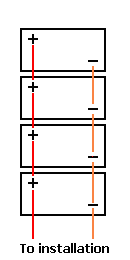I found this site last night and registered immediately because there's such good info here. I have been reading lots of posts and have two questions that I'd appreciate being pointed to answers if they are already discussed.
First Question:
The Crown 235 battery is identical in size but weights 5 lbs more than the T-105 (and has a better warranty) leading me to believe it has heavier plates and will outlast the Trojan. But, when I compare life cycles, the Trojan is better.
Here are the data:
Depth of discharge/#of Cycles T-105/C-235
100% T-105=750 CR-235=500
50% T-105=1600 CR-235=1200
40% T-105=2000 CR-235=1500
20% T-105=4000 CR-235=3000
All data supplied by the manufacturers. Do people here think these are good values that are to be trusted i.e., the T-105 will clearly outlast the Crown or is it possible that Crown reports conservatively while Trojan rigs the tests to give better than actual results? Why does the extra weight and presumably thicker plates of the Crown not translate into longer life?
Second Question:
I am putting together a 48V system to run a submersible pump and small shop. My usage can be tailored to coincide with good solar gain but I still wold like to have something like 400+ Ah of reserve.
I had planned 2 series of 8 6V batteries (240 Ah or so) in parallel to get to the magic 400+ but lots of posters say paralleling is a bad idea. I haven't yet found why they conclude that. Is there a "right" way to do it so it's OK? What about a parallel configuration is not good and shortens battery life?
I'm not trying to be argumentative, just trying to understand the physics of why parallel is a bad idea.
I appreciate the help, I am on a steep learning curve.
First Question:
The Crown 235 battery is identical in size but weights 5 lbs more than the T-105 (and has a better warranty) leading me to believe it has heavier plates and will outlast the Trojan. But, when I compare life cycles, the Trojan is better.
Here are the data:
Depth of discharge/#of Cycles T-105/C-235
100% T-105=750 CR-235=500
50% T-105=1600 CR-235=1200
40% T-105=2000 CR-235=1500
20% T-105=4000 CR-235=3000
All data supplied by the manufacturers. Do people here think these are good values that are to be trusted i.e., the T-105 will clearly outlast the Crown or is it possible that Crown reports conservatively while Trojan rigs the tests to give better than actual results? Why does the extra weight and presumably thicker plates of the Crown not translate into longer life?
Second Question:
I am putting together a 48V system to run a submersible pump and small shop. My usage can be tailored to coincide with good solar gain but I still wold like to have something like 400+ Ah of reserve.
I had planned 2 series of 8 6V batteries (240 Ah or so) in parallel to get to the magic 400+ but lots of posters say paralleling is a bad idea. I haven't yet found why they conclude that. Is there a "right" way to do it so it's OK? What about a parallel configuration is not good and shortens battery life?
I'm not trying to be argumentative, just trying to understand the physics of why parallel is a bad idea.
I appreciate the help, I am on a steep learning curve.

Comment